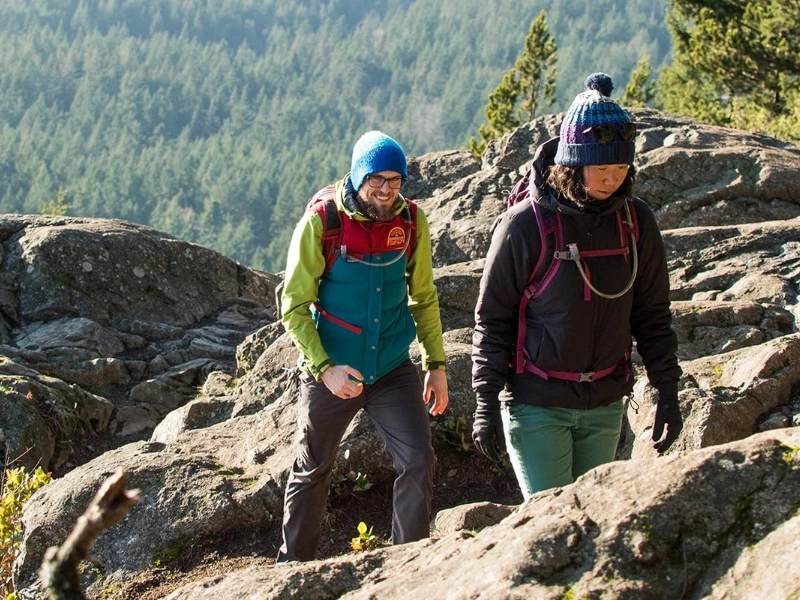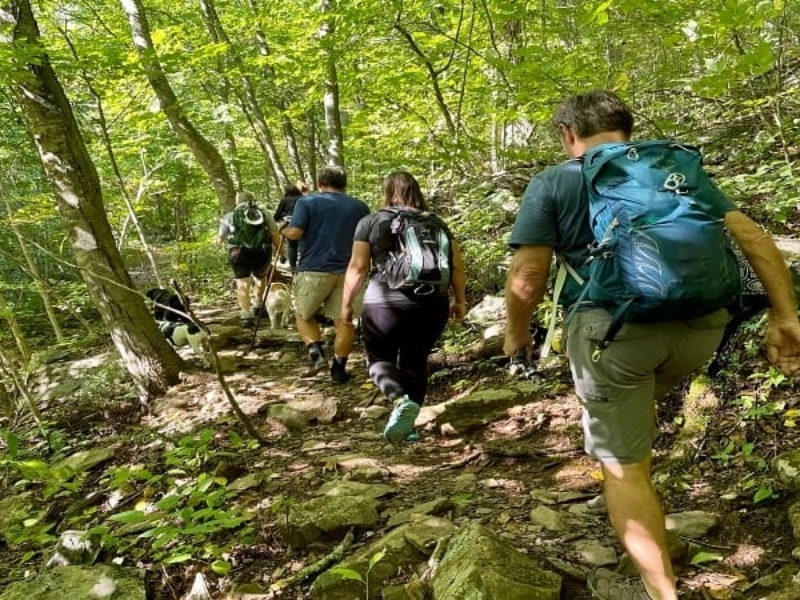Hiking is a fantastic way to get an excellent workout and take in the beauty of the outdoors. It lowers the chance of falls, develops muscles, enhances balance, and, as a weight-bearing activity, strengthens bones to help prevent osteoporosis. Hiking is a low-impact exercise that raises your heart rate without wearing you out. That makes it the ideal supplement to your exercise regimen.

 In addition to strengthening your legs and balance, hiking works your core muscles and stabilises your body by activating the little stabilising muscle groups in your torso. Additionally, you need to use various muscles for ascending and descending as the terrain gets steeper.
Hiking enhances mood in addition to increasing cardiovascular fitness, stamina, and toning muscles. Spending time in nature has been linked to studies to reduce stress and cortisol levels, as well as improve concentration.
If you become overly enthusiastic, you may easily undertake hikes that are too difficult for your level of fitness. This can lead to injury and even burnout. To avoid that, Cortese advises gradually increasing your distance and elevation—aiming for no more than 10% per week. This allows your body to adjust without overtaxing it. Additionally, the steady increase in intensity reduces the risk of injury.
In addition to strengthening your legs and balance, hiking works your core muscles and stabilises your body by activating the little stabilising muscle groups in your torso. Additionally, you need to use various muscles for ascending and descending as the terrain gets steeper.
Hiking enhances mood in addition to increasing cardiovascular fitness, stamina, and toning muscles. Spending time in nature has been linked to studies to reduce stress and cortisol levels, as well as improve concentration.
If you become overly enthusiastic, you may easily undertake hikes that are too difficult for your level of fitness. This can lead to injury and even burnout. To avoid that, Cortese advises gradually increasing your distance and elevation—aiming for no more than 10% per week. This allows your body to adjust without overtaxing it. Additionally, the steady increase in intensity reduces the risk of injury.
 Hiking is an intense physical activity that tests your stamina as well as your mental fortitude. You may sharpen your problem-solving abilities and increase your focus for the remainder of the day by navigating trails, studying maps, and pushing yourself through a strenuous climb. These activities will also help you sleep better at night.
Since hiking typically entails ascending and descending a trail, it strengthens your legs' major muscles, including your quadriceps, hamstrings, calves, and glutes. Because the ground is rarely level, you constantly engage your core muscles to maintain your balance as you climb over logs and avoid slick rocks.
Additionally, hiking at higher altitudes helps you become acclimated to exercising in low-oxygen environments, which improves your endurance in general. Nell Rojas, a professional marathoner, is one of the numerous athletes who incorporate it into their training regimens.
Hiking is an intense physical activity that tests your stamina as well as your mental fortitude. You may sharpen your problem-solving abilities and increase your focus for the remainder of the day by navigating trails, studying maps, and pushing yourself through a strenuous climb. These activities will also help you sleep better at night.
Since hiking typically entails ascending and descending a trail, it strengthens your legs' major muscles, including your quadriceps, hamstrings, calves, and glutes. Because the ground is rarely level, you constantly engage your core muscles to maintain your balance as you climb over logs and avoid slick rocks.
Additionally, hiking at higher altitudes helps you become acclimated to exercising in low-oxygen environments, which improves your endurance in general. Nell Rojas, a professional marathoner, is one of the numerous athletes who incorporate it into their training regimens.
 Hiking requires your body to move in a variety of ways, such as lateral stepping and traversing uneven ground. This can help you develop your internal balance system. Additionally, it stimulates your brain's hippocampal and retrosplenial cortical regions, which are in charge of navigation and spatial memory.
The majority of hikes involve climbing in the ascending direction and descending in the returning direction, which works your large leg muscles, particularly your quads, hamstrings, and calves. The descents can also strengthen your hip flexors and glutes. Hiking still requires your muscles to move laterally as you sidestep around fallen trees or find your footing on rutted tracks, even if you decide against trekking downward.
Hiking is a fantastic aerobic activity that improves your upper and lower bodies and increases endurance. It's also a fun way to take in the scenery. But keep in mind that you should increase your distance and elevation gradually, starting out modestly. Doing too much too quickly may result in injuries, and you may not realize the full health benefits of the activity.
Hiking requires your body to move in a variety of ways, such as lateral stepping and traversing uneven ground. This can help you develop your internal balance system. Additionally, it stimulates your brain's hippocampal and retrosplenial cortical regions, which are in charge of navigation and spatial memory.
The majority of hikes involve climbing in the ascending direction and descending in the returning direction, which works your large leg muscles, particularly your quads, hamstrings, and calves. The descents can also strengthen your hip flexors and glutes. Hiking still requires your muscles to move laterally as you sidestep around fallen trees or find your footing on rutted tracks, even if you decide against trekking downward.
Hiking is a fantastic aerobic activity that improves your upper and lower bodies and increases endurance. It's also a fun way to take in the scenery. But keep in mind that you should increase your distance and elevation gradually, starting out modestly. Doing too much too quickly may result in injuries, and you may not realize the full health benefits of the activity.